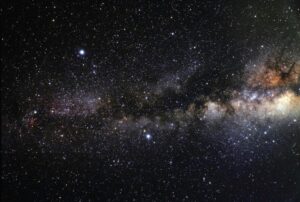What to look for in the late summer sky
August 2, 2024
Posted by Lake Erie Nature and Science Center

The summer night sky is a treasure trove of exciting objects to see with the naked eye. The difficulty most people face with summer observing is that the stars do not appear until well into the night, after many of us have gone to sleep. However, if you wake up before sunrise or look up after sunset, there is plenty to observe in the late summer sky.
Morning Sky (about 5 a.m. EDT)
In the east before sunrise, you will see two planets close to the horizon including bright Jupiter. Above Jupiter in the southern sky will be red Mars. Both planets will be above the familiar constellation, Orion the Hunter. Seeing Orion fully risen in the morning sky reminds us that summer will fade into winter in a few short months. We last observed Orion in early May as he gradually disappeared from view in the west after sunset.
In the southwest is Saturn. Saturn is the most distant planet we can see with our naked eye. It is about 9.5 times the distance from the Earth to the sun, or about 900 million miles from the sun. Saturn will be dimmer in the sky than Jupiter and Mars, but it will still shine brighter than the surrounding stars.
Evening Sky (immediately after sunset)
In the evening sky immediately after sunset, look for Venus shining brightly near the western horizon. Venus is the third brightest object in the sky after the Sun and the full moon. Venus is close to Earth and covered completely in highly reflective clouds which direct the sunlight back to us.
The next full moon will occur on Monday, August 19. The August full moon is sometimes called the Sturgeon Moon as it coincides with sturgeon fish becoming more abundant in the Great Lakes. Before August 19, look for the waxing (or growing) moon in the daytime sky and early evening. After August 19, look for the waning (or shrinking) moon after sunset through the early morning.
Asterisms, Constellations, and Meteor Showers
Look for the bright Summer Triangle towards the middle of the sky once the sun sets. It will resemble a large slice of pizza, pointing south. The Summer Triangle is an asterism, or a noticeable pattern of stars, that can help you spot a few constellations in the summer sky. The brightest star at the top of triangle, Vega, is part of Lyra the Harp. The southernmost star, Altair, is part of Aquila the Eagle. The northernmost star and dimmest of the three is Deneb, the tail feather of Cygnus the Swan.
Keep your eyes peeled for the Perseid Meteor Shower, peaking August 11 – 13. The moon will be around the first quarter phase during the peak, so the best time to observe the meteor shower without excess light will be from midnight to dawn.
Interested in astronomy? Join Lake Erie Nature & Science Center for a daytime planetarium show, Telescope Night program, or Astronomy Club meeting. View schedule and reserve tickets at www.lensc.org/planetarium. 28728 Wolf Road, Bay Village, OH 44140.

